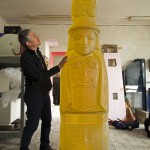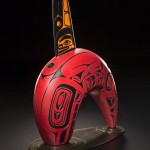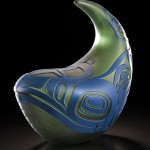Subscribe to Our Newsletter
Preston Singletary: Native Language
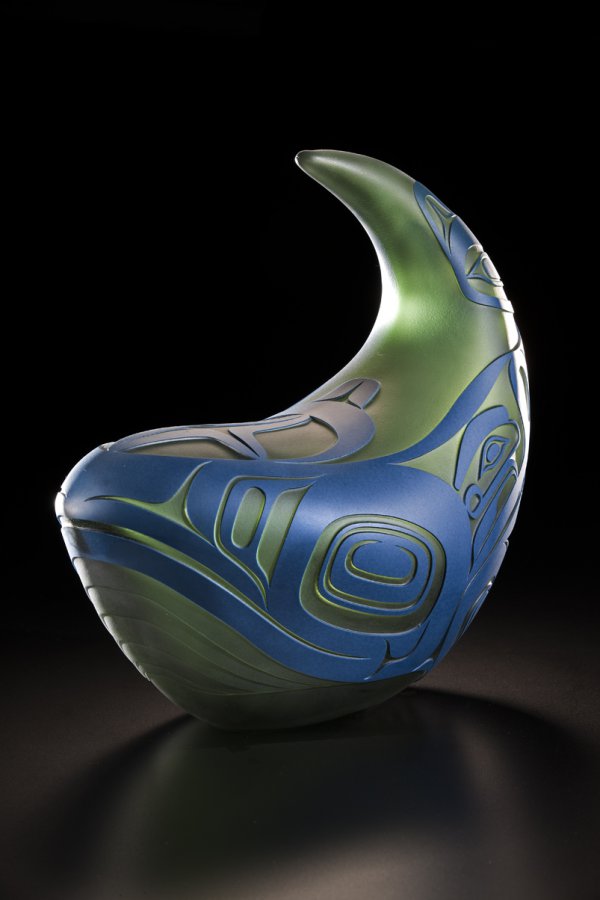
Preston Singletary merges contemporary art glass with Northwest Coast tradition.
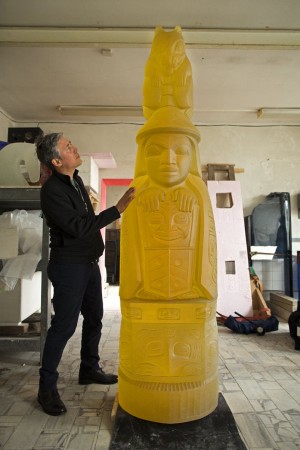
Preston Singletary in the studio with his totem pole;
Featured Images: (Click to Enlarge)
- Preston Singletary in the studio with his totem pole;
- Preston Singletary, Porpoising Killer Whale, 2014, blown and sandcarved glass, steel base, 21.5 x 16 x 8.5 inches.
- Preston Singletary, Gray Whale, 2013, blown and sandcarved glass, 13.5 x 13.5 x 7.5 inches.
- Preston Singletary, Beyond the Distant Sea, 2013, blown and sandcarved glass, 21 x 11 x 3.5 inches.
Preston Singletary’s latest work is a totem pole. It’s seven and a half feet tall and made of amber-colored glass, carved all over with intricate Northwest Coast motifs. It weighs 2,000 pounds and consists of three parts fused together. Singletary is based in Seattle, the art glass capital of the U.S., but the sculpture had to be cast in the Czech Republic, where, says the artist, the world’s best mold-making and casting is done.
For Singletary, this imposing object represents a step forward in terms of scale and ambition, but it’s very much in line with the work he’s been doing for the last three and a half decades, which emerged from a confluence of his Native American ancestral traditions and the Euro-American art and science of studio glass. Both those traditions are based in the Pacific Northwest—the movement that flowered at the Pilchuck Glass School in Seattle, spearheaded by Dale Chihuly and John and Anne Hauberg, and the culture of the Tlingit (pronounced “Klinkit”) people of southeastern Alaska and western Canada, from whom Singletary is descended. In fact, the totem pole could be said to embody the various elements of Singletary’s being.
“The pole itself has all the clan affiliations that represent my tribe and clan, the Killer Whale and the Eagle,” Singletary explains. Although he was born and raised in San Francisco, of mixed Tlingit, Filipino, and Anglo-American heritage, he spent the summer of 1981, when he was 17, in Douglas, Alaska, where his grandmother, a full-blooded Tlingit, was born. He still makes trips there as often as he can, every other year or so. The figure in the center of the pole represents Singletary’s great-grandmother, who, he says, “is where my Tlingit roots come from.” According to family lore, she once had a grizzly bear cub as a pet, which is depicted at the very top of the pole. “Totem poles traditionally tell a story, and we come from an oral tradition,” says Singletary. “For me, it was kind of an endeavor to create this large sculpture but also to tell a story of my connection to the culture.”
The culture of the Northwest Coast Indians—Tlingit, Haida, Tsimshian, and Kwakiutl—is particularly rich visually. The densely packed, stylized animal and human figural elements of totem poles, masks, house-front carvings, spoon handles, rattles, blankets, and tattoos, usually rendered in black, red, and white, challenge the eye with their intricate geometry. The American anthropologist Franz Boas made Northwest Coast art and design the centerpiece of his great, pioneering study Primitive Art (1927). “[The symbolic art’s] essential characteristics,” he writes, “are an almost absolute disregard for the principles of perspective, emphasis of significant symbols and an arrangement dictated by the form of the decorative field.” In this rigorous art, a sort of visual algebra depends on a vast vocabulary of modular building-block shapes. Singletary says, “There’s a sense of classic style. There are two simple elements, the ovoid and the ‘U’ form, and then little pointed details are added that kind of split up the space. If you look at the length of any element, it resolves itself into that ‘U’ form, but abstracted and extended. You can create any variation.”
He creates his own variations, much as a traditional Tlingit carver would, but the biggest one of all is the use of a medium that is totally absent from Tlingit material culture. There is something startling about seeing forms translated from painted wooden objects into translucent carved glass. The iridescent surfaces, the light that glows from inside, the bright, very un-Tlingit colors such as electric blue, golden amber, and sea green, combine to bring the ancient symbols and forms into the 21st century. “I realized at one point that glass had the ability to bring a new dimension to indigenous art,” says Singletary. “I’ve come to think of glass work as a process of science and industry and artisanship, because you have to understand a lot of things about glass before you can change its direction and try new things. The way the glass interacts with the light, it has almost like an inner spirit to it that is revealed when the light hits it.”
Singletary’s involvement with glass came about almost by accident. Originally he was set on a career as a rock musician, not an artist. (In fact, he’s still very much immersed in music. He records with two bands—Little Big Band plays “Native American funk,” while Khu’eex is “an avant-garde funk-rock-jazz kind of thing.”) One of his high school friends was future glass-art star Dante Marioni, who after graduation asked him to fill in as a night watchman at a glass-blowing studio in Seattle. Soon Singletary was learning the techniques himself, and in 1984 he began attending Pilchuck as a student. One of his mentors there was David Swenson, whom he met in 1989, around the time he got the idea of incorporating Tlingit motifs in his glass work. The germ of the glass totem pole actually dates back to those early days: “We worked on a project together in 2001 where we carved a totem pole, iterating the story of the founders of the Pilchuck Glass School. So when I had the idea to create my own totem pole, he was the carver on that project.” Singletary’s expertise is in blowing hot glass; in order to achieve the effect he was after, he had to collaborate with other artists who specialize in carving and kiln casting.
Collaboration is a way of life for Singletary, who has often used his skills to help others realize their ideas in glass form. “I love to collaborate,” he says. “Glass-blowing is a team effort anyway, so as an activity it feels like a collaboration. To create more complex forms you need a team. I was a glass-blowing assistant in the beginning, so I’m used to helping other people achieve their vision.” He credits one of his teachers, the great Venetian glass master Lino Tagliapietra, with impressing on him the importance of fostering the work of others: “He spent a lot of time working with other artists and helping them develop the techniques they went on to use. Working with other artists shows me more of the possibilities that can be realized with hot glass.”
Most prominent among the artists he has collaborated with is the Santa Fe-based potter Tammy Garcia. Together they created a series of elegant glass versions of traditional Pueblo clay vessels. “When I was showing in Santa Fe in the early days, I perceived a little bit of resistance to the glass medium,” recalls Singletary. “We showed the collector market what could be done with glass. Some people would like to keep Native art in a cultural corral, as I like to call it.” He points out that even classic, time-honored Native arts such as Navajo rug-making were profoundly influenced by new materials introduced by whites. Tlingit art became more refined through the adoption of steel tools from Russian traders along the Northwest Coast. “Glass itself has a connection with Native American culture,” he says, “through trade beads, which were adopted, accepted and used for ornamentation.”
Some of Singletary’s collaborations have taken him far from the Native American world, to work with Maori, Australian Aboriginal, and Native Hawaiian artists. “I see myself as a bit of an ambassador of glass to other indigenous people. Thereby I learn how other artists interpret their cultures, their styles, stories, and symbolisms. Since it shows me what the possibilities are, it’s inspiring for me to work with other people.”
Among his own people, Singletary’s desire to give back has recently found expression in a commission for a cultural arts center that will open in Juneau, Alaska, in May. It is named for the great Tlingit scholar and religious leader Walter Soboleff, who died in 2011 at the age of 102. It’s a large, multi-panel series that he calls a “kind of heraldic screen” similar to a type that would stretch across a traditional Tlingit longhouse. Among the symbolic emblems on the six-foot-tall carved glass panels are eagles and raven warriors.
Unlike many Native American artists today, Singletary doesn’t deal in satire and eschews references to the ironies and absurdities of contemporary Native American life in a white world. “I really admire a lot of these artists that are making work that is provocative or social commentary,” he says, “but my work tends to be decorative in a way. It takes on a deeper meaning because I try to attach a very traditional look to it. It’s really hard to make glass comment on the culture in the same way that a painter would, or a sculptor. But I really admire that in people who can balance that perspective.”
His own mission is to revivify traditional legends and symbols, to tell stories, and to create beautiful objects that will carry ancient visions into the future. Speaking about one of his sculptures, a glass version of a shaman’s healing rattle in the form of an oystercatcher bird, Singletary starts talking about a figure on the piece that represents a human being in the process of being transformed into a land otter. In traditional Tlingit lore, he explains, “if you were to die by drowning, the land otter people would come and take you and transform you into a land otter, drag you down into the village of the land otters. The killer whale people and other peoples had their own worlds, their own villages. That’s how it goes in the mythologies.”
These things are very real for Singletary, not necessarily in the literal sense that they were for his ancestors, but in a way that he feels is very important to transmit to contemporary Tlingit people as well as non-Natives. “I wasn’t raised with any religious instruction,” he ways. “My life really kind of transformed when I got into sweat-lodge ceremonies and hanging with my mentors who supported me in my evolution as an artist. When you become a keeper of cultural knowledge, it becomes a responsibility.”

